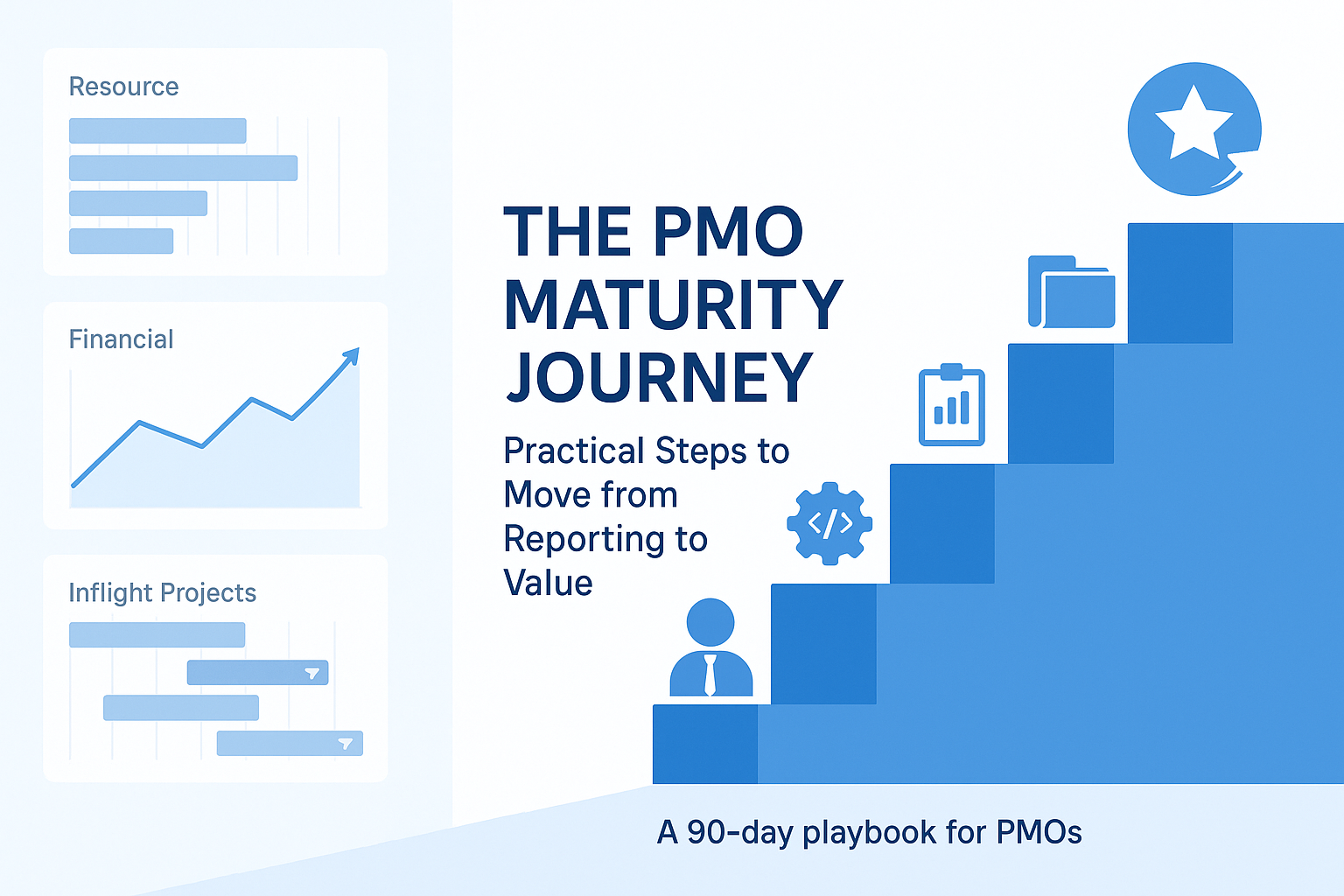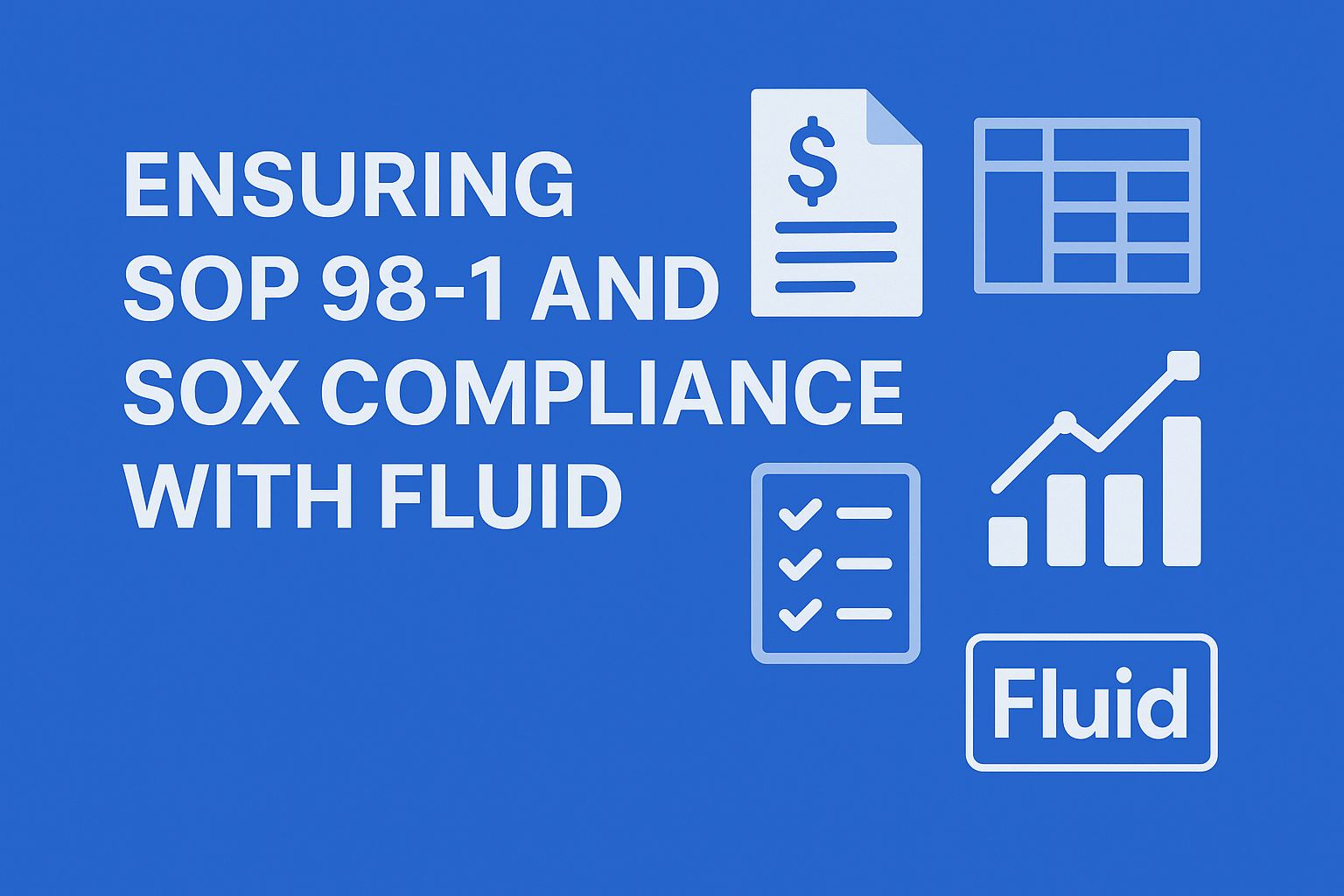The PMO Maturity Journey: Practical Steps to Move from Reporting to Value

PMO maturity is not a single leap; it is a sequence of disciplined steps that tighten governance, improve data quality, accelerate decision-making, and evidence portfolio value. This article outlines a pragmatic, quarter-by-quarter approach you can act on immediately, grounded in the realities of how modern PMOs operate and supported by Fluid’s all-in-one PPM platform across governance, intake, resourcing, financials, reporting, meeting management and AI-assisted insights.
Where are you on the journey?
Use this simple maturity lens to baseline today and plan your next move. It avoids external labels and focuses on outcomes.
- Administrative PMO
- Ad-hoc status updates; spreadsheets and slide decks dominate
- Limited control of intake or prioritisation
- Meetings capture discussion, but actions are not systematically tracked or closed
- Operational Reporting PMO
- Regular reporting cadence established
- Central repository for schedules, risks, issues and actions for inflight projects
- Some benefits and cost tracking, though inconsistent across projects
- Standardised Delivery PMO
- Common templates and methodologies across projects and programmes
- Intake workflow with business cases
- Emerging resource management discipline; timesheets used for actuals
- Strategic Portfolio PMO
- Portfolio planning aligned to business drivers; demand vs capacity managed
- Financials, benefits, and total cost of ownership tracked at portfolio level
- Decision-ready reports produced to schedule with minimal manual effort
- Value-Led Centre of Excellence
- Outcome-oriented governance with KPI-driven reviews
- Predictive insights guide prioritisation and mid-cycle rebalancing
- Executive confidence built on a single version of the truth across meetings, boards and inflight projects
The next 90 days: a practical playbook (move one level at a time)
A. Administrative → Operational Reporting
Objective: establish rhythm, visibility and accountability.
Implement this quarter
- Weekly data hygiene on status, schedule, risks, actions and dependencies in a unified workspace.
- Automated reporting pack for sponsors; stop rebuilding slides by hand.
- Meeting discipline: standard agendas, instant minutes, and action tracking from every session. Sync with Outlook to remove double-entry.
KPIs to evidence progress
- Report cycle time (data cut → distribution)
- % actions closed on time (from meeting to completion)
B. Operational Reporting → Standardised Delivery
Objective: drive consistency and reduce variance in delivery.
Implement this quarter
- Common templates for status, RAID, business case and change requests in your central PMO tool—no local copies.
- Intake workflow for ideas and requests through to approval, so nothing bypasses governance.
- Resource foundations: define roles, skills/pools and start schedule-based allocation for critical work.
KPIs to evidence progress
- % projects using standard templates
- Lead time from request submission to approval
- Resource over-allocation reduced week-over-week
C. Standardised Delivery → Strategic Portfolio
Objective: make prioritisation, capacity and funding decisions with confidence.
Implement this quarter
- Portfolio views that roll up status, risks, financials and resourcing across inflight projects and approved pipeline; replace spreadsheet roll-ups with live dashboards.
- Financial governance at scale: multi-year forecasts and budgets; track benefits realisation and ongoing costs at project and portfolio level.
- Scheduled, decision-ready reporting aligned to executive cadence (e.g., monthly steering, quarterly board).
KPIs to evidence progress
- Proposal-to-approval lead time
- Forecast vs actual variance (cost and capacity)
- Portfolio benefits realisation trend
D. Strategic Portfolio → Value-Led CoE
Objective: optimise continuously and prove enterprise value.
Implement this quarter
- Decision velocity: Engage stakeholders with a view of all actions, risks and approvals across meetings, boards and inflight projects. Change decision cadence to async.
- Predictive and AI-assisted insights to flag risks, spotlight bottlenecks and support scenario choices.
- Benefits governance: ensure owners record benefits and roll these up to portfolios for ROI conversations.
KPIs to evidence progress
- Time-to-decision from report publication
- % initiatives with active benefit profiles
- Portfolio ROI and TCO trend line
The operating system of a modern PMO (and how Fluid supports each step)
One platform, complete coverage
A single system should connect intake, schedules, risks, actions, financials, resourcing and reporting—so teams update once and stakeholders trust the data. Fluid provides an all-in-one PPM software package with project workspaces, dashboards, boards, meeting management and collaboration, designed for PMOs and project teams.
Governance and reporting without the admin drag
Replace manual slide creation with scheduled reports and configurable exports. Fluid supports automated reporting, custom export templates (including Word and PowerPoint), and scheduled distribution, allowing your PMO to spend time on insight rather than assembly.
Meeting management that actually moves the needle
If decisions and actions from steering groups are not captured and tracked centrally, maturity stalls. Fluid’s meeting management provides standard agendas, instant minutes, attendee tracking and action follow-up—and integrates with Outlook to minimise administrative overhead.
Intake and prioritisation as a controlled pipeline
Establish a transparent funnel from idea to approved initiative. Fluid enables automated request, business case and project workflows, with community submissions where appropriate—giving sponsors a clear line of sight on what’s coming and why.
Resource management that sees around corners
Mature PMOs plan capacity, not just tasks. With resource pools, roles, and schedule-based allocation, managers can match demand to supply and spot overloads before they hit delivery dates. Timesheet workflows provide auditable actuals for finance and performance reporting.
Financials and benefits where sponsors live
Executive sponsors care about benefits, ongoing costs and total cost of ownership. Fluid includes benefits realisation, multi-year forecasting, and portfolio-level roll-ups—so budgeting, re-forecasting and ROI conversations can be run from the same source of truth.
A single work hub to accelerate decisions
As maturity increases, the bottleneck often shifts to coordination. Fluid’s WorkHub creates a single view of who needs to do what by when across meetings, boards and inflight projects, raising follow-through and shortening time-to-decision.
Built for PMOs and project teams
Fluid is built for PMOs, bringing together portfolio planning, project delivery, governance, reporting and collaboration—so maturity gains are reinforced by everyday ways of working, not eroded by tool sprawl.
Implementation guardrails (what to standardise, what to tailor)
- Standardise the data model (project attributes, status fields, risk taxonomy, benefit categories) so reporting scales. Use configurable dashboards and fields to do this without bespoke builds.
- Tailor governance depth by business area: regulated units may need tighter approvals and audit trails; digital product teams can run lighter gates with the same reporting backbone. Portfolio-level reporting keeps both aligned.
- Align to executive cadence: set your reporting schedule to meet steering and board dates; automate distribution to eliminate scramble.
- Close the loop in meetings: insist that every decision and action is captured against the work and tracked to completion. Meeting minutes and action tracking should be part of the same system as projects and boards.
Example 90-day plan you can copy
Month 1
- Stand up the core project workspace templates (status, RAID, schedule, high-level financials) and migrate inflight projects.
- Implement weekly data hygiene and a monthly scheduled report to the sponsor group.
Month 2
- Launch the intake workflow with a lightweight business case; route all new requests through it.
- Define resource pools and begin schedule-based allocation for your top five initiatives.
Month 3
- Extend financials to detailed resource and non-resource cost and forecast (time-phased), linking to resourcing actuals and purchase commitments.
- Introduce benefits registers for all strategic projects; configure portfolio roll-ups.
- Centralise all governance meetings in the system, auto-issuing minutes and actions; publish the work hub for visibility across teams and inflight projects.
What good looks like after two quarters
- Cycle time down: reports appear on schedule without manual rework; decisions are taken sooner.
- Confidence up: sponsors see the same numbers in meetings, reports and dashboards.
- Capacity planned: hotspots are visible early; resource moves are deliberate rather than reactive.
- Value evidenced: benefits and ongoing costs are tracked alongside delivery, supporting ROI and TCO discussions at portfolio level.
Call to action
- See it live: Book a Fluid demo tailored to your current maturity stage.
- Start the 90-day plan: Configure templates, intake, meeting management and reporting in week one.
- Prove value fast: Switch on benefits realisation and portfolio roll-ups to put ROI at the centre of your executive conversations.
About Fluid
Fluid is an all-in-one platform built for PMOs and project teams. It connects portfolio planning, delivery, governance and collaboration in a single system—covering intake, scheduling, risks, actions, financials, resourcing, reporting, meeting management and AI-assisted insights—so organisations can deliver strategic value faster.
See how Fluid enables your business to deliver the right strategic change













